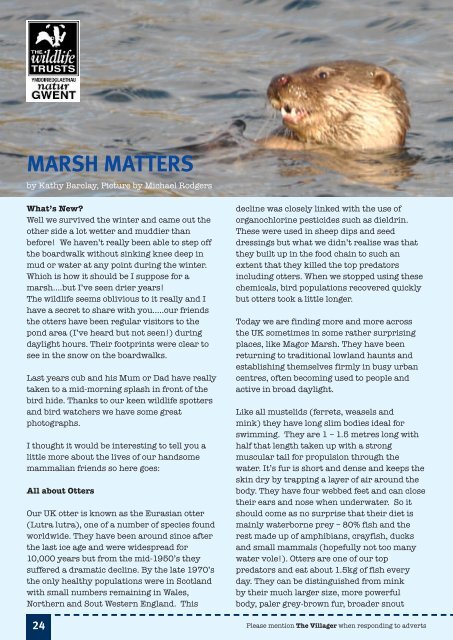The Villager
Create successful ePaper yourself
Turn your PDF publications into a flip-book with our unique Google optimized e-Paper software.
MARSH MATTERS<br />
by Kathy Barclay, Picture by Michael Rodgers<br />
What’s New?<br />
Well we survived the winter and came out the<br />
other side a lot wetter and muddier than<br />
before! We haven’t really been able to step off<br />
the boardwalk without sinking knee deep in<br />
mud or water at any point during the winter.<br />
Which is how it should be I suppose for a<br />
marsh….but I’ve seen drier years!<br />
<strong>The</strong> wildlife seems oblivious to it really and I<br />
have a secret to share with you…..our friends<br />
the otters have been regular visitors to the<br />
pond area (I’ve heard but not seen!) during<br />
daylight hours. <strong>The</strong>ir footprints were clear to<br />
see in the snow on the boardwalks.<br />
Last years cub and his Mum or Dad have really<br />
taken to a mid-morning splash in front of the<br />
bird hide. Thanks to our keen wildlife spotters<br />
and bird watchers we have some great<br />
photographs.<br />
I thought it would be interesting to tell you a<br />
little more about the lives of our handsome<br />
mammalian friends so here goes:<br />
All about Otters<br />
Our UK otter is known as the Eurasian otter<br />
(Lutra lutra), one of a number of species found<br />
worldwide. <strong>The</strong>y have been around since after<br />
the last ice age and were widespread for<br />
10,000 years but from the mid-1950’s they<br />
suffered a dramatic decline. By the late 1970’s<br />
the only healthy populations were in Scotland<br />
with small numbers remaining in Wales,<br />
Northern and Sout Western England. This<br />
24<br />
decline was closely linked with the use of<br />
organochlorine pesticides such as dieldrin.<br />
<strong>The</strong>se were used in sheep dips and seed<br />
dressings but what we didn’t realise was that<br />
they built up in the food chain to such an<br />
extent that they killed the top predators<br />
including otters. When we stopped using these<br />
chemicals, bird populations recovered quickly<br />
but otters took a little longer.<br />
Today we are finding more and more across<br />
the UK sometimes in some rather surprising<br />
places, like Magor Marsh. <strong>The</strong>y have been<br />
returning to traditional lowland haunts and<br />
establishing themselves firmly in busy urban<br />
centres, often becoming used to people and<br />
active in broad daylight.<br />
Like all mustelids (ferrets, weasels and<br />
mink) they have long slim bodies ideal for<br />
swimming. <strong>The</strong>y are 1 – 1.5 metres long with<br />
half that length taken up with a strong<br />
muscular tail for propulsion through the<br />
water. It’s fur is short and dense and keeps the<br />
skin dry by trapping a layer of air around the<br />
body. <strong>The</strong>y have four webbed feet and can close<br />
their ears and nose when underwater. So it<br />
should come as no surprise that their diet is<br />
mainly waterborne prey – 80% fish and the<br />
rest made up of amphibians, crayfish, ducks<br />
and small mammals (hopefully not too many<br />
water vole!). Otters are one of our top<br />
predators and eat about 1.5kg of fish every<br />
day. <strong>The</strong>y can be distinguished from mink<br />
by their much larger size, more powerful<br />
body, paler grey-brown fur, broader snout<br />
Please mention <strong>The</strong> <strong>Villager</strong> when responding to adverts



